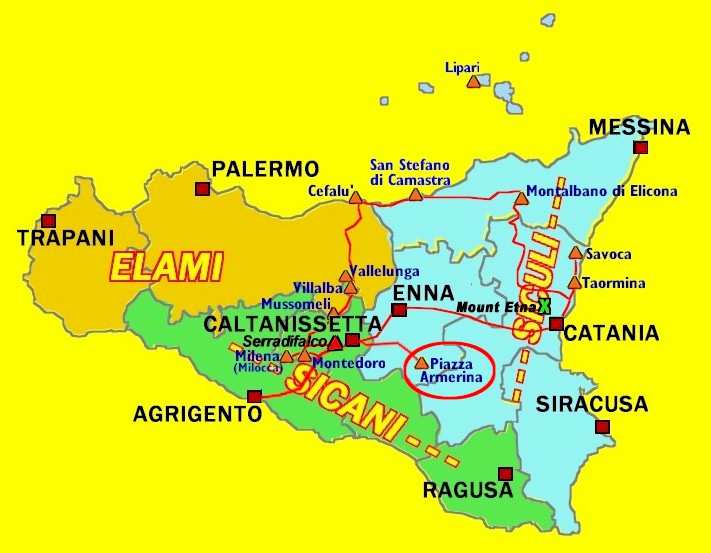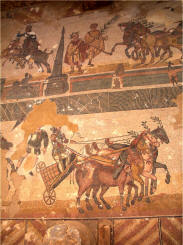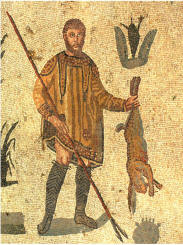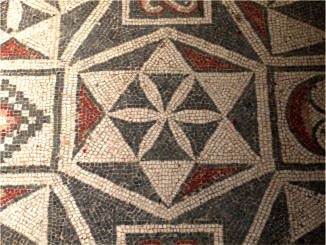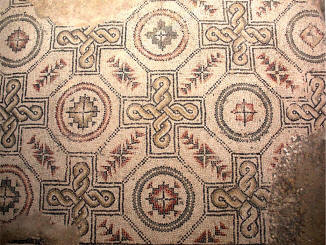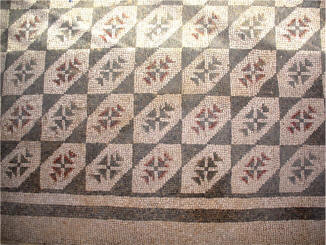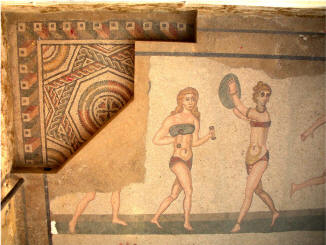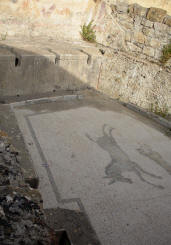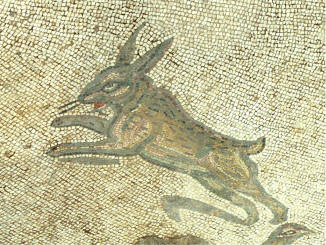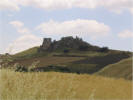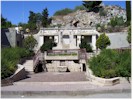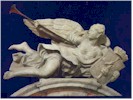|
The Villa Romana al Casale near Piazza Armerina is an ancient Roman villa with restored mosaics.
It was constructed on the remains of an older villa in the
first quarter of the fourth century, probably as the center
of a huge latifundium (estate) covering the entire
surrounding area.
How long the villa kept this role is not
known, maybe for less than 150 years, but the complex
remained inhabited and a village named Platia
grew around it. It was damaged during the domination of
the Vandals and the Visigoths, but the buildings remained in
use, at least in part, during the Byzantine and Arab period.
The site was finally abandoned for good when a landslide
covered the villa in the 12th century CE, and remaining
inhabitants moved to the current town of Piazza Armerina.
Pieces of mosaics and some columns
were found early in the 19th century, and some excavations
were carried out later in that century, but the first
serious excavations were performed by Paolo Orsi in 1929,
and later by Giuseppe Cultrera in 1935-39. The latest major
excavations were in the period 1950-60 by Gino Gentile after
which the current exhibit was built.
The floors show bathing beauties, a chariot
race, the trials of Hercules, wild animals of every stripe,
and intriguing geometriic patterns, all defined with 3/4
inch stone bits over an area of thousands of square feet. |
La Villa Rumana al Casale vicinu Piazza
Armerna e 'na villa Rumana anziana cu i musaichi
risturati. Era costruita ncapu di na villa ruvinata cchiù
vecchia, in primu quartu dellu seculu 4, prubabilmenti comu
lu centru d'un latifundiu granni, ncapu tutte i terri
vicini.
Quant'anni 'sta villa c'era nun si
sapi, forsi menu di centucinquant'anni, ma la banna rimana e
nu villagiu chiamatu Platia crisci' tutt'inturnu. Era
guastatu mentri u tempu dei Vandali, ma i pallazzi eranu
usati, al menu in parti, nel tempi dei Bizantini e dei Mauri.
Lu pustu finalmenti era abbandunatu pe daveru quannu nu
terremotu ha cuperta la villa in seculu 11, e i genti si s'mufaru a lu currenti paisi di Piazza Armerina.
Pizzi di musaichi e certi colunni
eranu truvati prestu in seculu 18, e quarchi scavati eranu
fatti tannu, ma i primi scavati seriusi erano fatti di Paolo
Orsi in 1929, e dopu di Giuseppe Cultrera in 1935-36.
I scavati maggiori cchiù recenti eranu in tempu 1950-60 di
Gino Gentile, e dopu lu currenti espustu era costruitu.
I pavimenti fannu vidiri i donni al bagnu, na cursa dei carruzzi,
i tribulaziuni di
Erculi, armali servaggi di tutti strisci e disigni
geumetrichi interessanti, tutti fatti cu petruzzeddi comu i
punti dei jiteddi, ncapu u campu di granizza milli di pedi. |
